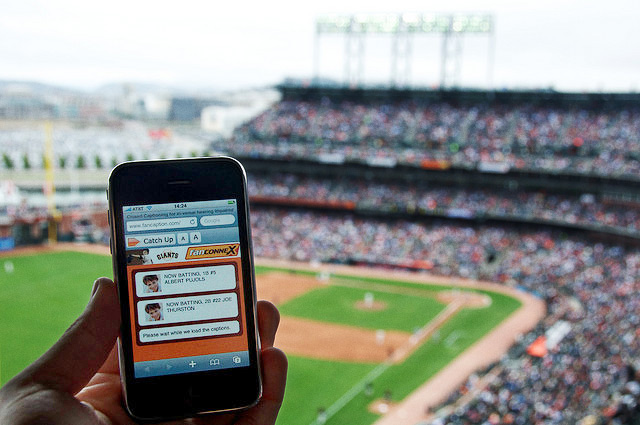The way spectators view live sporting events is changing along with mobile technology. Sports fans can often be found occupied by their smartphones during the game, or shooting selfies in the stadium to share with friends over social networks.
Sports organizations already know the importance of social networking and connecting with fans outside the stadium, but new Wi-Fi options inside the stadium have given organizations another way to reach fans during games.
The Challenges of Good Stadium Wi-Fi Networks

Image Courtesy of Shutterstock.com
Sports fans clearly want to be able to use their smartphones inside arenas and stadiums, allowing them to post pictures from the game, update Twitter with game commentary, check stats, and see which of their friends are at the game. During Super Bowl XLVIII in February 2014, a whopping 3.2 terabytes of data were transferred across the stadium wifi system. Most of the server hits were for social networks, including fans uploading over five photos per second to Instagram for the duration of the game. But it’s not easy creating a Wi-Fi network that can service tens of thousands of people at one time in a relatively small area.
Hoping to improve the in-game experience for fans, the NFL recently created standards for Wi-Fi service in its stadiums. Major League Baseball, the NBA, and the NHL all are putting together similar studies regarding what needs to be done to provide fans with the wireless Internet service they demand. In order to meet demand, some stadiums are partnering with Wifi providers to roll out their specialized networks.
The Seattle Seahawks are partnering with Verizon Wireless to rollout their new stadium Wifi which they have announced with a clever social media campaign. By hiding giant Seahawks helmets around Seattle and inviting fans to find them, Verizon and the Seahawks have created a stimulating social media campaign, appropriately social savvy given the importance of the stadium Wifi network in running social campaigns.
Other recent football stadium Wi-Fi improvements and plans around the United States include:
- Atlanta. The new Atlanta Falcons stadium, set to open in 2017, is expected to be the most technologically advanced stadium in the world.
- Lincoln. The University of Nebraska football team’s Memorial Stadium unveiled a new Wi-Fi network configuration for the 2014 college football season.
- San Francisco. San Francisco’s new football stadium, Levi’s Stadium, offloaded 2.13 terabytes of data on its Wi-Fi network during its first preseason game in August 2014.
What Stadium WiFi means for Social Networking
Stadium WiFi systems will make it easier for teams to implement a strong social media strategy.
- Hashtag campaigns. When the home team makes a remarkable play, messaging on jumbotrons can encourage fans to immediately use a particular Twitter hashtag to generate comments about the play, hoping to grab the attention of ESPN SportsCenter. Or teams can encourage fans to upload selfies from the game with a certain hashtag, and then show those photos during timeouts on the jumbotron.

- Selling Merchandise. Fans love to purchase souvenirs at the game. Teams can use social networks and in-stadium Wi-Fi to give fans in attendance virtual coupons to use at the in-stadium souvenir shop or to alert fans to new products.
- Ticket sales. When fans are having a good time in the stadium, it’s a great opportunity to use social networking to offer them additional tickets to future games. Tying discounted tickets in with a hashtag campaign can provide the ideal incentive to get fans to post to social and buy seasons tickets.
- Real-time information and comments. Teams can use Twitter to keep their fans in the loop regarding stats and team news during the game. Fans could also be encouraged to share comments during the game that would be displayed on the jumbotron. Fans can even vote over social networks to select the MVP for the game.

As stadiums across the country roll out wifi networks that can handle the crowds, there will be a number of untapped opportunities for engaging with fans through their phones. How do you think WiFi will change the fan experience? How will teams take advantage of their newfound ability to reach out to fans through social? The possibilities are numerous, but they probably involve hashtags…
 Felicity Dryer is a journalist based in Los Angeles, California. Originally a health writer, she has begun to branch out into writing about technology, which has been a passion of hers since she was young. In her free time, she enjoys hosting game nights with her friends and spending her warm days on the beach. She looks forward to seeing wireless internet access improve and expand into something universal.
Felicity Dryer is a journalist based in Los Angeles, California. Originally a health writer, she has begun to branch out into writing about technology, which has been a passion of hers since she was young. In her free time, she enjoys hosting game nights with her friends and spending her warm days on the beach. She looks forward to seeing wireless internet access improve and expand into something universal.




